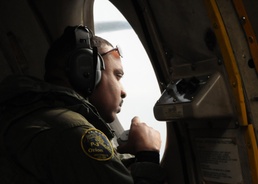
NAVAL AIR FACILITY MISAWA, Japan – Patrol Squadron 4 took to the air from Naval Air Facility Misawa March 22, to conduct an eight-hour field survey of ports in northern Japan.
Since their reposition to NAFM on March 16, the squadron is continuing its relief efforts by gathering information on the current status of ports, roads and infrastructure in cities along the eastern coastline that were affected by the recent earthquake and tsunami.
With the P-3 squadron’s communication and real-time capabilities, the Navy will gain more knowledge of where it can provide vital humanitarian and relief support in Operation Tomodachi.
“I think the mission has been going very well,” said Lt. Peter Kennedy, a Klamath Falls, Ore., native who serves as a patrol plane commander assigned to Patrol Squadron 4. “As a P-3 Squadron we are able to adapt on short notice which has made our efforts here so successful. We are receiving great support from Commander, Task Force 72 staff and overall our team is providing a very good product.”
The Hawaii-based squadron’s move to NAFM from Kadena Air Base in Okinawa, Japan, has increased the squadron’s time on site and reduced their time in transit.
According to Lt. j.g. Hector Robles, assigned to VP 4 and originally from Fajardo, Puerto Rico, the move has been a big plus for them.
“While we had success flying out of Kadena, the location we are in today provides us with greater time on site,” he said. “The work we have been doing here is very rewarding.”
Another effort to increase their effectiveness is by conducting eight-hour flight missions from NAFM. This way the Squadron takes advantage of sunlight so they can gather better imagery on site.
Petty Officer 2nd Class Jeff Graham, naval air crewman (operational level), assigned to VP 4 and a native of Bakersfield, Calif., operates the Advanced Imagining Multi-spectrum Sensor aboard the aircraft. The sensor, located on the nose of the aircraft, takes detailed imagery and has streaming video capabilities.
Graham said some of the images he has seen have been hard to believe. However, he is confident that with help from the U.S. and the determination of the Japanese people, the “Land of the Rising Sun” will recover from the disaster.
“It will take a while,” he said. “I do think the more resources and information that is provided to the Japanese people will help things continue to get better for the country.”
For more news from Naval Air Facility Misawa, visit https://www.cnic.navy.mil/misawa or check out our Facebook page at http://www.facebook.com/nafmisawa.